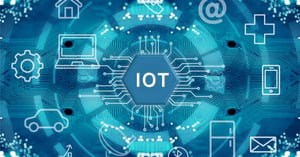Ever since the idea of a smart city was first introduced, Internet of Things technology has been a key pillar of smart city development. As technology advances and more countries embrace next-generation connectivity, IoT technology will continue to grow and have a bigger effect on the way we live. In this article, we explore IOT and its importance for the development of smart cities.
According to numbers from the Improving Internet of Things (IoT) Security with Software-Defined Network (SDN) study, there will be more than 75.44 billion connected IoT devices by 2025. With a forecast of over 7.33 billion mobile users by 2023 and more than 1,105 million connected wearable device users by 2022, the Internet of Things is expected to grow into one of the smartest collective and collaborative systems in history.
With room for so much potential and opportunity across a wide range of sectors, including urban mobility, security, sustainability, maintenance, healthcare, and management, cities must understand the benefits and opportunities of the Internet of Things for Smart Cities.
Sophisticated interconnectivity is one of the fundamental building blocks of next-generation smart city development. Citizens and governments will be connected in ways that we’ve never seen before. IoT will deliver huge opportunities and benefits to smart cities, but this level of interconnectivity will also bring its own set of challenges.
What is IoT (internet of things)?
According to the ITU (International Telecommunication Union), the term Internet of Things is a broad term that can be used to describe any object connected to the Internet. However, in recent years, the term IoT is increasingly being used to specifically describe objects that can “talk” to each other.
It references the vast network of digital devices that communicate and interact with each other, and affect our daily lives. These devices include smart sensors, monitoring devices, AI programs, and actuators that can evaluate, monitor, and control certain aspects of city life. For example, data about the weather can be collected by multiple sensors, which can then be used to manage thermostats in public buildings, cutting emissions, and saving the city money.
There is no uniform definition of what the Internet of Things is, and different organizations and individuals may suggest differences from one definition to the next. However, they all agree that the IoT is “a set of technologies for accessing the data collected by various devices through wireless and wired Internet networks.”
Why is IoT - the Internet of Things - so important for Smart Cities?
IoT is important for every city. Currently, the world’s largest cities are Tokyo, Delhi, Shanghai, and Sao Paolo, with populations of 38 million, 29 million, 26 million, and 21 million respectively. Today, these megacities are notable because of their huge populations. In the future, there will be many more like them, with even denser populations.
It’s predicted that more than 60% of the planet’s population will live in cities by the year 2030. It’s a bold prediction and one that could spell disaster if the appropriate measures aren’t taken. Large populations demand large resources. Residents will need access to water, efficient and environmentally friendly transportation, clean air, and practical sanitation and waste management. With the clever use of smart city practices and the widespread deployment of IoT technology, the cities of tomorrow will be able to meet the demands of their residents effectively and efficiently.
Connected technologies and big data can create smart solutions. These solutions can solve problems, increase the quality of life for a city’s residents, and lower the consumption of resources. For a truly smart city to function at its full potential, the Internet of Things is a vital ingredient.
Examples of Smart City IoT Solutions
According to IoT Analytics, smart cities are prioritizing Internet of Things technology in several interesting ways. The study focused on decision-makers from some of the world’s leading smart cities (including Barcelona, Paris, Amsterdam, and Palo Alto) and categorized how leaders were using IoT to curb urban inefficiencies and improve the quality of life for their citizens.
The study found that the following areas were the top priorities* for city governments:
- Connected public transport (74%)
- Traffic monitoring and management (72%)
- Water level / Flood monitoring (72%)
- Video surveillance and analytics (72%)
- Connected streetlights (68%)
- Weather monitoring (68%)
- Air quality / Pollution monitoring (68%)
- Smart metering – water (66%)
- Fire / Smoke detection (66%)
- Water quality monitoring (64%)
*Percentages shown are the percentage of included smart cities that have deployed use cases as part of a smart city initiative.
From the top 10 listed above, let’s look at some examples of how cities are effectively using Internet of Things technology to solve urban issues.
🎤 Hear more about AI and what it brings to the Smart City Landscape in our bee smart city Podcast. 🎤
Connected Public Transport
The Polish city of Lublin was awarded the title of Smart City of the Year within its population class in 2016, largely thanks to its largest smart city project: an innovative passenger information system for connected public transport.
The system revolutionized the city’s bus transit system. It did this by installing GSM and GPRS devices on vehicles, that transmit real-time data to a dispatch centre software, which then relays that information to electronic displays at bus stops and to online portals. This resulted in more efficient public transport, cutting waiting times, and boosting reliability.
Traffic Monitoring
Managing traffic flow is one of the biggest challenges for smart cities. Thanks to IoT, there are some practical solutions. In Los Angeles, the city government has installed a vast network of pavement-integrated sensors. These sensors transmit real-time traffic updates to a traffic management platform, which adjusts the timing of traffic signals to optimize traffic flow.
Water Level Monitoring
The city of Dublin’s innovative Smart Docklands project has hundreds of exciting ideas. However, the city’s flood monitoring program is one that directly affects citizens. In recent years, flooding has become a problem in areas of the city. To remedy this, the Dublin City Council searched for solutions. The result was the Low-Cost Gully Management initiative. This program saw six companies rise to the challenge of developing sensor products that can detect water levels and report flooding incidents using LoRaWAN and Sigfox technologies.
Video Surveillance
Smart video surveillance isn’t a new concept. In fact, smart surveillance cameras have been around for a long time, and they’re commonly used to police the world’s roads and highways. ANPR (Automatic Number Plate Recognition) or ALPR (Automatic License Plate Recognition) cameras are commonly used by law enforcement to identify stolen cars, for traffic control purposes, to collect tolls, and to deter crime in general.
It’s true that smart surveillance cameras are becoming more advanced and may be used to predict crimes before they happen in the future. They may also be able to identify pedestrians and log their movements. However, heavy surveillance methods like these aren’t popular, with many citizens voicing privacy concerns and questioning the use of their personal data.
Connected Streetlights
Connected streetlights and lighting solutions are a very popular way to boost the productivity of a smart city. The key benefits of smart lighting include a reduction of energy and maintenance costs, increased public safety, safer traffic, and a measurable environmental impact. Smart streetlights can also be used to double up as EV chargers, emissions monitors, and wireless broadband connection points.
There are many prime examples of successfully connected streetlight implementations, but here are a few brief notable success stories:
- Copenhagen, Denmark - The city of Copenhagen’s smart lighting solution has dramatically reduced energy costs by approximately 60%.
- Bristol, UK - In Bristol, the local government has replaced the city's original street lights with a new system. This has resulted in cost savings of over £1 million per year.
- Barcelona, Spain - Barcelona has installed a network of smart street lights that also provide mobile broadband connectivity. They can also be used for further IoT functionality in the future.
Are you interested in IoT-related tenders?
Check out our Tender Premium Service now with a free trial!
How Can IoT Solutions Help Smart Cities in the Future?
The future of our cities is interconnected with the future of IoT. As city governments begin to unlock the full potential of urban data platforms, AI, smart devices, and interconnectivity, the need for IoT will grow exponentially. This will lead to efficient problem-solving, smart mobility, sustainability, and more.
One of the most exciting ways that IoT can benefit future cities is by reducing the need for private vehicles. With the advent of driverless cars upon us, it won’t be long until efficient public transport can be made accessible to everyone, powered by IoT technology. The cars and buses of the future will be able to operate using data transmitted by street furniture or streetlights, delivering an efficient and seamless traffic flow.
Though far less glamorous, the future of waste management is another way that IoT can improve our cities of tomorrow. Right now, waste collection and disposal are two of the biggest obstacles that cities have. Smart waste management solutions include route planning tools and real-time bin capacity levels that can reduce collection volumes and inform citizens on better ways to dispose of their waste.
These are just two of the many ways that IoT will improve the quality of life for citizens of future smart cities.
Internet of Things for Smart Cities: Conclusion
IoT has unlimited potential. With large-scale implementation, thoughtful deployment, and careful management, IoT, urban data platforms, big data, and artificial intelligence can transform our urban hubs into smart, sustainable, and efficient spaces. The secret to the success of all sectors, from healthcare to manufacturing, and from transportation to education, is through the shared use of information. By gathering data and actuating practical solutions, our next-generation smart cities will be smarter than ever before.
Explore IoT solutions for smart cities in the leading global smart city network and community. Discover hundreds of solutions that have been implemented in cities and communities across the globe, connect with thousands of members to exchange best practices and form new partnerships. Join today with a free basic membership!



